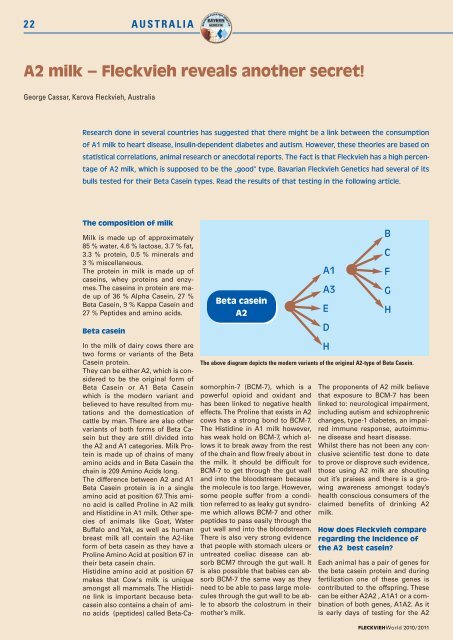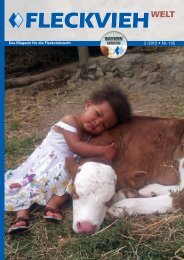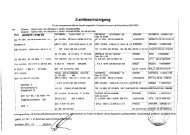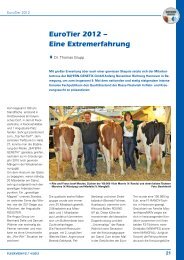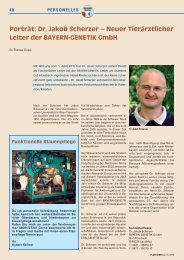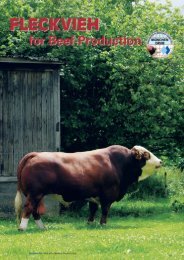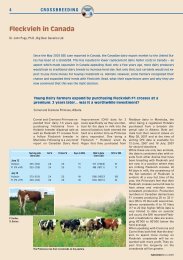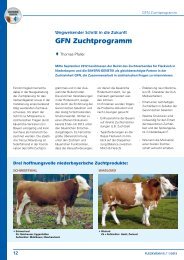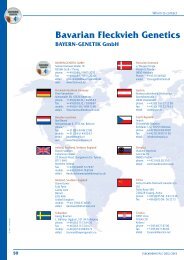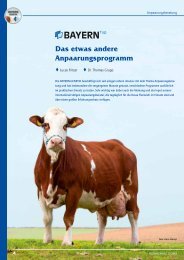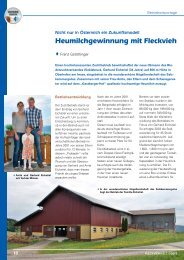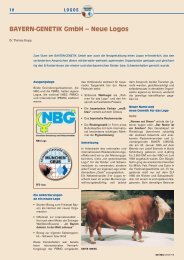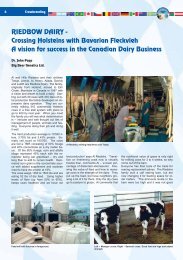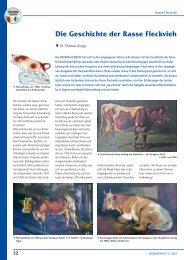A2 milk ? Fleckvieh reveals another secret!
A2 milk ? Fleckvieh reveals another secret!
A2 milk ? Fleckvieh reveals another secret!
You also want an ePaper? Increase the reach of your titles
YUMPU automatically turns print PDFs into web optimized ePapers that Google loves.
22 AUSTRALIA<br />
<strong>A2</strong> <strong>milk</strong> – <strong>Fleckvieh</strong> <strong>reveals</strong> <strong>another</strong> <strong>secret</strong>!<br />
George Cassar, Karova <strong>Fleckvieh</strong>, Australia<br />
Research done in several countries has suggested that there might be a link between the consumption<br />
of A1 <strong>milk</strong> to heart disease, insulin-dependent diabetes and autism. However, these theories are based on<br />
statistical correlations, animal research or anecdotal reports. The fact is that <strong>Fleckvieh</strong> has a high percentage<br />
of <strong>A2</strong> <strong>milk</strong>, which is supposed to be the „good” type. Bavarian <strong>Fleckvieh</strong> Genetics had several of its<br />
bulls tested for their Beta Casein types. Read the results of that testing in the following article.<br />
The composition of <strong>milk</strong><br />
Milk is made up of approximately<br />
85 % water, 4.6 % lactose, 3.7 % fat,<br />
3.3 % protein, 0.5 % minerals and<br />
3 % miscellaneous.<br />
The protein in <strong>milk</strong> is made up of<br />
caseins, whey proteins and enzymes.<br />
The caseins in protein are made<br />
up of 36 % Alpha Casein, 27 %<br />
Beta Casein, 9 % Kappa Casein and<br />
27 % Peptides and amino acids.<br />
Beta casein<br />
In the <strong>milk</strong> of dairy cows there are<br />
two forms or variants of the Beta<br />
Casein protein.<br />
They can be either <strong>A2</strong>, which is considered<br />
to be the original form of<br />
Beta Casein or A1 Beta Casein<br />
which is the modern variant and<br />
believed to have resulted from mutations<br />
and the domestication of<br />
cattle by man. There are also other<br />
variants of both forms of Beta Casein<br />
but they are still divided into<br />
the <strong>A2</strong> and A1 categories. Milk Protein<br />
is made up of chains of many<br />
amino acids and in Beta Casein the<br />
chain is 209 Amino Acids long.<br />
The difference between <strong>A2</strong> and A1<br />
Beta Casein protein is in a single<br />
amino acid at position 67. This amino<br />
acid is called Proline in <strong>A2</strong> <strong>milk</strong><br />
and Histidine in A1 <strong>milk</strong>. Other species<br />
of animals like Goat, Water<br />
Buffalo and Yak, as well as human<br />
breast <strong>milk</strong> all contain the <strong>A2</strong>-like<br />
form of beta casein as they have a<br />
Proline Amino Acid at position 67 in<br />
their beta casein chain.<br />
Histidine amino acid at position 67<br />
makes that Cow's <strong>milk</strong> is unique<br />
amongst all mammals. The Histidine<br />
link is important because betacasein<br />
also contains a chain of amino<br />
acids (peptides) called Beta-Ca-<br />
Beta casein<br />
<strong>A2</strong><br />
The above diagram depicts the modern variants of the original <strong>A2</strong>-type of Beta Casein.<br />
somorphin-7 (BCM-7), which is a<br />
powerful opioid and oxidant and<br />
has been linked to negative health<br />
effects. The Proline that exists in <strong>A2</strong><br />
cows has a strong bond to BCM-7.<br />
The Histidine in A1 <strong>milk</strong> however,<br />
has weak hold on BCM-7, which allows<br />
it to break away from the rest<br />
of the chain and flow freely about in<br />
the <strong>milk</strong>. It should be difficult for<br />
BCM-7 to get through the gut wall<br />
and into the bloodstream because<br />
the molecule is too large. However,<br />
some people suffer from a condition<br />
referred to as leaky gut syndrome<br />
which allows BCM-7 and other<br />
peptides to pass easily through the<br />
gut wall and into the bloodstream.<br />
There is also very strong evidence<br />
that people with stomach ulcers or<br />
untreated coeliac disease can absorb<br />
BCM7 through the gut wall. It<br />
is also possible that babies can absorb<br />
BCM-7 the same way as they<br />
need to be able to pass large molecules<br />
through the gut wall to be able<br />
to absorb the colostrum in their<br />
mother’s <strong>milk</strong>.<br />
A1<br />
A3<br />
E<br />
D<br />
H<br />
B<br />
C<br />
The proponents of <strong>A2</strong> <strong>milk</strong> believe<br />
that exposure to BCM-7 has been<br />
linked to: neurological impairment,<br />
including autism and schizophrenic<br />
changes, type-1 diabetes, an impaired<br />
immune response, autoimmune<br />
disease and heart disease.<br />
Whilst there has not been any conclusive<br />
scientific test done to date<br />
to prove or disprove such evidence,<br />
those using <strong>A2</strong> <strong>milk</strong> are shouting<br />
out it’s praises and there is a growing<br />
awareness amongst today’s<br />
health conscious consumers of the<br />
claimed benefits of drinking <strong>A2</strong><br />
<strong>milk</strong>.<br />
How does <strong>Fleckvieh</strong> compare<br />
regarding the incidence of<br />
the <strong>A2</strong> best casein?<br />
Each animal has a pair of genes for<br />
the beta casein protein and during<br />
fertilization one of these genes is<br />
contributed to the offspring. These<br />
can be either <strong>A2</strong><strong>A2</strong> , A1A1 or a combination<br />
of both genes, A1<strong>A2</strong>. As it<br />
is early days of testing for the <strong>A2</strong><br />
F<br />
G<br />
H<br />
FLECKVIEHWorld 2010/2011
Beta Casein protein, the studies done<br />
to date in 10 countrys and across<br />
7 dairy breeds between 1982 and<br />
2006 show that <strong>Fleckvieh</strong> had the<br />
2nd highest frequency of the <strong>A2</strong> Beta<br />
Casein Protein. Six studies included<br />
Holsteins, three studies included<br />
Jerseys and one study each<br />
one Ayrshire, Guernsey, Brown<br />
Swiss, Milking Shorthorn and <strong>Fleckvieh</strong>.<br />
The <strong>Fleckvieh</strong> study was published<br />
in the Czech Journal of animal<br />
Science in 2006 and was conducted<br />
on 440 animals of the Czech <strong>Fleckvieh</strong><br />
breed. Of the 440 <strong>Fleckvieh</strong> animals<br />
tested:<br />
67 % tested <strong>A2</strong><strong>A2</strong><br />
30 % tested A1<strong>A2</strong><br />
3 % to the A1A1<br />
The opposite graph shows results<br />
on tests done to date to compare<br />
between breeds and from it can be<br />
seen the high incidence of the <strong>A2</strong><br />
Beta Casein gene in <strong>Fleckvieh</strong>.<br />
These results are consistent with<br />
expectations and show a high percentage<br />
of bulls carrying the <strong>A2</strong> Beta<br />
Casein gene, therefore giving<br />
great scope for those wishing to<br />
pursue <strong>A2</strong><strong>A2</strong> breeding within their<br />
herd.<br />
The scientific results obtained to<br />
date are very promising for <strong>Fleckvieh</strong>.<br />
Should the additional health<br />
benefits of <strong>A2</strong> <strong>milk</strong> prove true this<br />
would be <strong>another</strong> big advantage<br />
for <strong>Fleckvieh</strong>.<br />
<strong>A2</strong>-tests on 9 bulls from<br />
Bavarian <strong>Fleckvieh</strong> Genetics<br />
Engadin <strong>A2</strong><strong>A2</strong><br />
Rustico <strong>A2</strong><strong>A2</strong><br />
Waterberg <strong>A2</strong><strong>A2</strong><br />
Seebär <strong>A2</strong><strong>A2</strong><br />
Mandela A1<strong>A2</strong><br />
Don Juan A1<strong>A2</strong><br />
Hippo A1<strong>A2</strong><br />
Round Up A1<strong>A2</strong><br />
Manitoba A1A1<br />
Whilst the author has sourced the above<br />
information from articles and research that<br />
is currently available, the author, nor Bavarian<br />
<strong>Fleckvieh</strong> Genetics endorse any<br />
claims made regarding the benefits or consequence<br />
of drinking A1 or <strong>A2</strong> <strong>milk</strong>. The sire Waterberg is homocygous for the <strong>A2</strong>-type of Beta-Casein.<br />
FLECKVIEHWorld 2010/2011<br />
100<br />
90<br />
80<br />
70<br />
60<br />
50<br />
40<br />
30<br />
20<br />
10<br />
0<br />
AUSTRALIA 23<br />
Allelic frequencies of β-Casein genotypes of different breeds<br />
<strong>Fleckvieh</strong> Holstein Brown Guernsey Milking Jersey<br />
Swiss Shorthorn<br />
<strong>A2</strong> A1 and others<br />
<strong>Fleckvieh</strong> Holstein Brown Guernsey Milking Jersey<br />
Swiss Shorthorn<br />
<strong>A2</strong> 71 % 55 % 66 % 96 % 49 % 50 %<br />
A1 and others 29 % 45 % 34 % 4 % 51 % 50 %<br />
Source: Milk Protein Polymorphisms in Califonia Dairy Cattle, Journal of Dairy Science, Volume 74, Issue 5, May 1991<br />
and Comparison of Influence Markers CSN3 and CSN2 on Milk Performance Traits in Czech Spotted and Holstein<br />
Cattle tested at first, fifth and higehr lactation, Nitra, Slovaca Universitas Agriculturae Nitriae, 2006.
24 AUSTRALIA<br />
Letter to the editor:<br />
Life Changing <strong>Fleckvieh</strong>’s.<br />
By the autumn of 2007, Vikki and I had come to the end of the line with trying to get our 160 Registered Holstein herd to<br />
a workable fertility level. We were at our lowest ebb. Our conception rates had slumped to a low of 10 % and A.I had been<br />
abandoned. We were just running Holstein herd bulls, who could only achieve only slightly better rates of conception,<br />
and broke down under the work load. We had also had abandoned all the herd improvement tools, including herd testing,<br />
as there was very little point of continuing with it as a marketing tool for any surplus cattle, as we had none. We<br />
needed every heifer as a replacement. This was very tedious, as it took 20 doses of semen to yield one heifer. We even<br />
got to the point of buying in <strong>milk</strong>ing cows to keep up our herd numbers. This is the point at which anger and disillusionment<br />
took hold of our souls. When we sought help, the fingers were always pointed at us, and our management. We weren’t<br />
doing this or that right. I can assure you, if your conception rates are as low as 10 %, you leave no stone unturned,<br />
you make sure your management is right!!<br />
Defining Moment<br />
When driving past Chris and Sharon Jordon’s Simmental stud, I got the idea to do something totally out of the square<br />
for me, crossing my registered Holsteins to a Simmental. I knew that the resulting progeny would be very saleable, and<br />
I had always known they had a reputation for high fertility. I had nothing to lose, and my sanity regained.<br />
I by chance took a fancy to a young bull of the <strong>Fleckvieh</strong> strain. He was sired by S.V. Bavarian, and his mother was an<br />
Austrian cow. He was old genetics, the result of a 20 year old stored embryo. As we chatted over the sale and his pedigree,<br />
Chris mentioned that we could <strong>milk</strong> young Bavarian’s daughters and that in fact his mother was herd recorded with<br />
some impressive production figures. Chris also gave me George Cassar’s number. By the time I had young Bavarian<br />
transported home and some semen collected from him, George had some Regio and Hippo semen delivered to my tank.<br />
Another Defining Moment<br />
It was at this time that I did something that people in the industry and people who knew me and my links to the Holstein<br />
breed, found incredible to believe; I tipped out my store of Holstein semen. For me it was an easy thing to do. I am an<br />
all or nothing person. I do my research and then go for it. Three weeks after we started using the <strong>Fleckvieh</strong> semen, our<br />
lifes changed. Around half of the cows I had inseminated held in calf. We took note, but we had been at this point with<br />
the Holsteins, only to see the conception rates deteriorate at 6 weeks and beyond. As we passed 6 weeks and then 3<br />
months, our conceptions were around 45 %. We knew we were back! The pressure release was enormous. We realized<br />
the problem wasn’t with us, it was with the Holstein’s. Three years on and we are waiting for our first F1 <strong>Fleckvieh</strong>’s enter<br />
the <strong>milk</strong>ing herd. We have been able to consistently get our conceptions above 50 %. Just this autumn, I became confident<br />
enough to conduct a synchronized mating program on our maiden F1 <strong>Fleckvieh</strong> heifers. Early conception rates are<br />
outstanding, a figure that we would have only once dreamed about and something George Casser said we would regain<br />
quickly.<br />
Defining Moment No. 3<br />
When our first <strong>Fleckvieh</strong> calves were born, it was then that we realised we had stumbled on to something special. These<br />
were the easiest calves to rear. No more nursing sickly calves. No more did I have the chore of administrating antibiotics,<br />
only to have the calves die in my arms. These F1’s wanted to live, they have a vitality I haven’t seen in calves for 15<br />
years. The next big thrill we got, was when we took our 5 day old bull calves to market. We were used to getting $ 45 for<br />
our Holsteins, with only one or two butchers bidding for them. We were taken aback when a number of calf rearers wanted<br />
to take our calves. The first year, our calves averaged $160 and that average has continued to rise due to the return<br />
buyers keen to reinvest again after seeing first hand how well these calves did. Recently George Cassar sent me some<br />
eartags with „<strong>Fleckvieh</strong>“ printed on them. I make sure that every calf that leaves the property has one of these tags. At<br />
the market I have stood back and watched potential buyers turn the ears and read these tags. Everybody in the market<br />
is now getting comfortable with the way „<strong>Fleckvieh</strong>“ rolls of the auctioneers tongue. At time of writing this article, our F1<br />
<strong>Fleckvieh</strong>’s are 1 month away from calving and they are home, getting accustomed to the dairy/<strong>milk</strong>ing shed and to the<br />
routine of their future <strong>milk</strong>ing lifes. It is a time when we start to get close to them and learn their personalities. We are<br />
also able to observe their conformations and also to compare them with their mothers that are in the herd. We are amazed<br />
that in one generation we are able to totally change the Holstein conformation to that of the <strong>Fleckvieh</strong>. A shape that<br />
will be very suitable to our grass based enterprise. <strong>Fleckvieh</strong> has taken away the tall narrow shoulders and ungainly legs.<br />
They have delivered an animal that will be able to walk distances and graze freely. Their rump set up is something that<br />
we have been searching for for a long time. One area that the naysayers have been trying to knock our confidence on is<br />
udder shape. But as we see them developing on their first calf, we are very confident that the udders will be very adequate<br />
and sound. Vikki has recently remarked to George, how I have regained my confidence to breed good cattle again,<br />
and that I have gotten back my swagger. This has come around because of the tremendous cattle I am seeing before me<br />
on a daily basis, and the potential they are showing me gets me excited.<br />
Go on change your life.<br />
Fire up with <strong>Fleckvieh</strong>!!!!!<br />
Greg Templeton, Australia<br />
FLECKVIEHWorld 2010/2011


